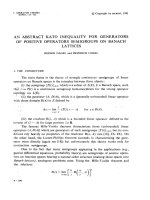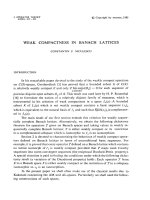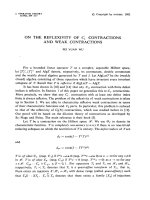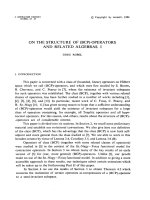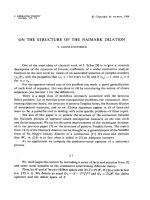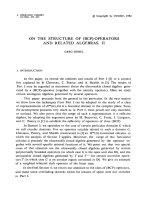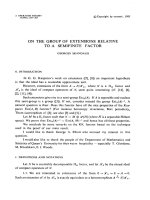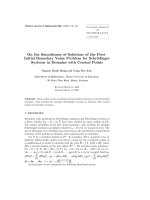Báo cáo toán học: "On the distribution of depths in increasing trees" ppsx
Bạn đang xem bản rút gọn của tài liệu. Xem và tải ngay bản đầy đủ của tài liệu tại đây (117.85 KB, 9 trang )
On the distribution of depths in increasing trees
Markus Kuba
Institut f¨ur Diskrete Mathematik und Geometrie
Technische Universit¨at Wien
Wiedner Hauptstr. 8-10/104, 1040 Wien, Austria
Stephan Wagner
Department of Mathematical Sciences
Stellenbosch University
Private Bag X1, Matieland 7602, South Africa
Submitted: Oct 28, 2009; Accepted: Oct 1, 2010; Published: Oct 15, 2010
Mathematics Subject Classifications: 05A19; 05C05 60C05
Abstract
By a theorem of Dobrow and Smythe, the depth of the kth no de in very simple
families of increasing trees (which includes, among others, binary increasing trees,
recursive trees and plane ordered r ecur s ive trees) follows the same distribution as
the number of edges of the form j −(j +1) with j < k. In this short note, we present
a simple bijective proof of this fact, which also shows that the result actually holds
within a wider class of increasing trees. We also d iscus s some related results that
follow from the bijection as well as a possible generalization. Finally, we use another
similar bijection to determine the distribution of the depth of the lowest common
ancestor of two nodes.
1 Introduction
Increasing trees are rooted labeled trees where the nodes of a tree of size n are labeled by
distinct integers from the set { 1 , . . . , n} in such a way that the sequence of labels along
any branch starting at the root is increasing. There are various important families of
increasing tr ees, such as binary increasing trees, recursive trees or plane-oriented recursive
trees. A general f ramework for these instances is given by what is known as simple families
of increasing trees [3]; such a family T is characterized by a sequence of non-negative
the electronic journal of combinatorics 17 (2010), #R137 1
numbers (ϕ
k
)
k0
, where ϕ
0
> 0. This sequence is called the degree-weight sequence. We
assume that there exists a k 2 with ϕ
k
> 0 to avoid trivialities.
Now we assign a weight w(T ) to a ny ordered tree T by w(T ) :=
v
ϕ
d(v)
, where v
ranges over all nodes of T and d(v) is the out-degree of v. Furthermore, let L(T ) be the
number of increasing labelings of T with integers 1, 2, . . . , |T |, as explained above, and
define the total weights by T
n
:=
|T |=n
w(T ) · L(T ). It follows that the exponential
generating function T (z) :=
n1
T
n
z
n
n!
satisfies the autonomous first order differential
equation
T
′
(z) = Φ
T (z)
, T (0) = 0, (1)
where Φ(t) =
∞
n=0
ϕ
n
t
n
. This equation follows easily from the fact that one can describe
a tree as a root node with several subtrees from t he same family at t ached to it (see for
instance [3] or [4]).
Important special cases include Φ(t) = (1+t)
2
, which corresponds to binary increasing
trees, Φ(t) = e
t
(recursive trees), and Φ(t) =
1
1−t
(plane-oriented recursive trees). In all
these cases, the total weight can simply be interpreted as the number of trees of given size
within the family. Binary trees are essentially equivalent to binary search trees, which in
turn serve as an analytic model for the famous Quicksort algorithm [8]. Plane-oriented
recursive trees, on the other hand, are a special instance o f the well known Barab´asi-
Albert model [2] for scale-free networks (see also [5]), which is used as a simplified growth
model of the world wide web [1].
From a combinatorial point of view, it is interesting to note that full binary increasing
trees (Φ(t) = 1+t
2
) are enumerated by the tangent numbers (see [10] for various interesting
bijections), while there are (n−1)! recursive trees, n! binary increasing trees and (2n−3)!!
plane-oriented recursive trees with n nodes.
A specific subclass of increasing trees is known as very simple families [11] of increasing
trees. The three aforementioned examples all belong to this subclass, which is essentially
characterized by the fact t hat the function Φ(t) is either of the form ( 1+ct)
α
for constants
c, α of the same sign (α < 0 or α ∈ { 2, 3 . . .}) or of the form e
ct
for some positive constant
c. These specific families have the property that they can be describ ed via a t ree evolution
process, as pointed out by Panholzer and Prodinger in [11].
A remarkable result by Dobrow and Smythe [7] states that the depth of the kth node
(i.e., the distance from the root) in a random increasing tr ee from one of the very simple
families follows the exact same distribution as the number of edges between two nodes
whose lab els are k and differ by exactly 1 (henceforth, we will simply call such edges
1-edges). See a lso [1 1]. The aim of this note is to show that this holds more generally
for simple families of increasing trees, and to present a simple bijective proof of this fact.
Several further corollaries follow a s well, and the bijection can also be generalized, see
Section 3.
Finally, we present another similar bijection and use it to determine the distribution
of the depth of the lowest common ancestor of two nodes i and j, i < j. It turns out
(somewhat surprisingly) that the distribution only depends on i, and that it converges to
a geometric distribution if i, j → ∞.
the electronic journal of combinatorics 17 (2010), #R137 2
2 The bijection
Let us now describe a bijection B
k
on t he set of ordered increasing trees as follows:
• If node j − 1 lies on the unique path from 1 to k in T and ℓ is its successor on this
path, then j takes the position of ℓ in B
k
(T ) (i.e., if ℓ is the rth child of j − 1 in T ,
then j is the rth child of j − 1 in B
k
(T )).
• If j k but node j − 1 does not lie on this path, then the parent of j in B
k
(T ) is
the same as the parent of j − 1 in T, and the position as a child is the same as well
(as before).
• If j > k, then the parents (and positions) of j in T and B
k
(T ) are the same.
The inverse operation B
−1
k
is equally simple:
• If j < k and nodes j and j + 1 are connected in T, then j lies on the path from 1 t o
k in B
−1
k
(T ), and the successor ℓ of j on this path takes t he position of j + 1 (i.e.,
if j + 1 is the rth child of j in T , then ℓ is the rth child of j in B
−1
k
(T )).
• If j < k but nodes j and j + 1 are not connected, then the parent of j in B
−1
k
(T ) is
the same as the parent of j + 1 in T , and the position as a child is the same as well.
• If j > k, then the parents (and positions) of j in T and B
−1
k
(T ) are the same.
It is easy to see that both operations are well-defined and inverses of each ot her.
Figure 1 shows an example with k = 9.
1
2
3 4
56
7
8
9
10
11
12
1
2
34
5
67
8
9
10
11
12
Figure 1: The bijection in an example: T (left) and B
9
(T ) (right).
The following properties of the bijection are immediate:
• For any increasing tree T with n k nodes, B
k
(T ) is an increasing tree with n
nodes and the same outdegrees.
• Edges on the path between the root a nd k are mapped to 1-edges in B
k
(T ) whose
ends are labeled with numbers k.
the electronic journal of combinatorics 17 (2010), #R137 3
Since all outdegrees remain the same, the weights w(T ) and w(B
k
(T )) are also always
the same, regardless of the degree-weight sequence ϕ. The following results are obtained
as a consequence. For very simple families of increasing trees, these theorems occur in the
aforementioned pap er by Dobrow and Smythe [7]. Our bijection provides a simple combi-
natorial explanation for these results, which were obtained by probabilistic techniques in
[7], with the additional benefit that they generalize to a wider range of increasing trees,
namely to all simple families.
Theorem 1 (cf. Dobrow/Smythe, Theorem 5)
In a random increasing tree with n nodes from a simple family, the probability that k is
attached to j is exactly the probability that the last 1-edge with labels k is between j and
j + 1.
More generally, the f ollowing holds:
Theorem 2 In a random increasing tree with n nodes from a simple family, the prob-
ability that the ancestors of k are j
1
, j
2
, . . . , j
s
in this order (j
1
> j
2
> · · · > j
s
) is the
same as the probability that the only 1-edges with labels between j
s
and k are j
1
− (j
1
+ 1),
j
2
− (j
2
+ 1), . . . , j
s
− (j
s
+ 1).
Theorem 3 (cf. Dobrow/Smythe, Theorem 7)
In a random increasing tree with n nodes from a simple family, the distribution of the
depth of node k is the same as the distribution of the number of 1-edges with labels k.
Furthermore, the probability that node j lies on the unique path between 1 and k is the
same as the probability that there is an edge between j and j + 1.
In particular, one has the following corollary:
Corollary 4 The probability that j lies on the path between 1 and k does not depend on
k.
Remark 1 None of the above theorems depends on the size of the increasing tree. In the
case of very simple families, which can be generated by a growth process, this is essentially
trivial, but it is quite surprising that this remains true within the more general setting of
simple families of increasing trees.
3 Generalization
Our bijection can be generalized further to prove the following:
Theorem 5 (cf. Dobrow/Smythe, Theorem 6)
In a random increasing tree with n nodes from a simple family, the distribution of the
distance between nodes i and k (i < k) is the same as the distribution of the sum of the
distance between i and i + 1 and the number of 1-edges with labels between i + 1 and k.
the electronic journal of combinatorics 17 (2010), #R137 4
To this end, consider a bijection B
i,k
that is defined as follows:
• If i+1 < j, node j −1 lies on t he unique path from 1 to k in T and ℓ is its successor
on this path, then j takes the position of ℓ in B
i,k
(T ) (i.e, if ℓ is the rth child of
j − 1 in T , then j is the rth child of j − 1 in B
i,k
(T )).
• If i + 1 < j k but no de j − 1 does not lie on t his path, then the parent of j in
B
i,k
(T ) is the parent of j − 1 in T , and the position as a child is the same as well.
• If j i or j > k, then the parents (and positions) of j in T and B
i,k
(T ) are the
same.
• Finally, we have to specify the parent of i + 1: let ℓ be the node in T that lies on
the path between i and k and has the smallest label > i. Suppose further that ℓ is
the rth child of node h in T . Then i + 1 is the rth child o f node h in B
i,k
(T ).
See Figure 2 for an example with i = 4 and k = 12. Note that the path between i and
k is mapp ed to the path between i and i + 1 and a collection of 1-edges, thereby proving
Theorem 5.
1
2
3 4
56
7
8
9
10
11
12
1
2
3 4
5 6
7
8
9
10 11
12
Figure 2: The g eneralized bijection in an example: T (left) and B
4,12
(T ) (right).
4 Common ancestors
Note that the distance between two nodes i and j (i < j) equals the sum of their depths,
minus the depth of their lowest common ancestor, which we will henceforth denote by
i ∧ j. Hence it is natural to study the distribution of the depth of the lowest common
ancestor. It turns out that this distribution has a discrete limit if we let i, j → ∞ (a
geometric limit distribution, to be precise), as opp osed to the Gaussian limit that follows
from the decomposition in Theorem 3 for very simple families. Perhaps more surprisingly,
the distribution only depends on the label i, but not on j, which is shown by yet another
similar bijection:
Theorem 6 In a random increasing tree with n nodes from a simple family, the distri-
bution of the depth of the lowest common ancestor of nodes i and j, i < j, is independent
of j.
the electronic journal of combinatorics 17 (2010), #R137 5
Proof: Clearly it suffices to show that the distribution is the same for i ∧ j and
i ∧ (j + 1). To this end, construct the following involution on the set of increasing trees:
if j is the parent of j + 1, nothing changes. Otherwise, interchange j and j + 1. This
is clearly possible without violating t he condition that the labels along a path from the
root increase. Furthermore, the collection of outdegrees and thus the weight of the tree
remains the same. If j is the parent of j + 1, then they have the same common ancestors
with i; otherwise, the common ancestors of i and j become the common ancestors of i
and j + 1, and vice versa. This proves the theorem and shows that it is sufficient to study
the lowest common ancestor of two nodes with successive labels i and i + 1.
Let us study the distribution of the depth of (n − 1) ∧ n, i.e., the lowest common
ancestor of the nodes n − 1 and n, in a simple increasing tree of size n; for very simple
trees that can be described by a gr owth process, this is also the distribution if the size
of the tree is greater than n, since the lowest common ancestor cannot change if more
nodes are added. We apply an approach via generating functions: let T (z, u) be the
biva riate g enerating function in which z marks the size of the tree, and u marks the depth
of (n − 1) ∧ n in a tree of size n. If n − 1 and n are in distinct branches, then the depth is
0, otherwise it is 1 plus the depth in the subtree that contains the two. Let (ϕ
k
)
k0
and
Φ(t) be a sequence and the associated power series, as explained in the introduction, a nd
let t
n
(u) be the nth coefficient of T(z, u) (which is—up to normalization—the probability
generating function of the depth of (n − 1) ∧ n). Then we have, for n > 2,
t
n
(u) =
k1
ϕ
k
r
1
+r
2
+···+r
k
=n−1
n − 1
r
1
, r
2
, . . . , r
k
t
r
1
(1)t
r
2
(1) · · · t
r
k
(1)
+
k1
ϕ
k
r
1
+r
2
+···+r
k
=n−3
k
j=1
n − 3
r
1
, r
2
, . . . , r
k
· t
r
1
(1)t
r
2
(1) · · · (ut
r
j
+2
(u) − t
r
j
+2
(1)) · · · t
r
k
(1).
The first summand accounts for the case that the depth is 0. In the second summand, we
consider all possible trees with the property that nodes n and n − 1 are in the same (the
jth) branch. It follows easily that T (z, u) =
n1
t
n
(u)
z
n
n!
satisfies
T
′′′
(z, u) = T
′′′
(z, 1) + (uT
′′
(z, u) − T
′′
(z, 1)) · Φ
′
(T (z, 1)),
where all derivatives are with respect to z. Since
T
′′
(z, 1) =
d
dz
T
′
(z, 1) =
d
dz
Φ(T (z, 1)) = T
′
(z, 1) · Φ
′
(T (z, 1)),
we can r ewrite this as
T
′′′
(z, u) = T
′′′
(z, 1) + (uT
′′
(z, u) − T
′′
(z, 1)) ·
T
′′
(z, 1)
T
′
(z, 1)
.
Solving the linear differential equation yields
T
′′
(z, u) = T
′′
(z, 1) + (u − 1)T
′
(z, 1)
u
z
0
T
′′
(y, 1)
2
T
′
(y, 1)
u+1
dy.
the electronic journal of combinatorics 17 (2010), #R137 6
With the additional conditions T (0, u) = 0 and T
′
(0, u) = 1 (which are not essential,
though), T(z, u) is uniquely determined. In general, there is no explicit expression for the
integral, but for very simple families of increasing trees, the formula simplifies:
• If Φ(t) = e
ct
for some c > 0, then T(z, 1) =
1
c
log
1
1−cz
, and after some simplifications
T
′′
(z, u) =
c
(2 − u)(1 − cz)
2
+
c(1 − u)
2 − u
(1 − cz)
−u
.
Now we can extract the coefficient of z
n
to obtain the probability generating function
t
n
(u)
t
n
(1)
=
[z
n
]T (z, u)
[z
n
]T (z, 1)
=
1
2 − u
1 −
n − 3 + u
n − 1
.
The precise probabilities can now be expressed in terms of Stirling numbers of the
second kind, and it is also obvious that this probability generating function converges
to
1
2−u
for all u < 2, which shows that the limit distribution for n → ∞ is Geom(
1
2
).
The average depth is precisely
n−2
n−1
.
• If Φ(t) = (1 + ct)
α
, then T (z, 1) =
1
c
(1 + c(1 − α)z)
1/(1−α)
− 1
, a nd we obtain
T
′′
(z, u) =
α(1 − α)c
1 − 2α + αu
1 + c(1 − α)z
1/(1−α)−2
+
α
2
c(u − 1)
1 − 2α + αu
1 + c(1 − α)z
αu/(1−α)
,
and the formula
t
n
(u)
t
n
(1)
=
1 − α
1 − 2α + αu
+
α(u − 1)
1 − 2α + αu
αu/(1 − α)
n − 2
1/(1 − α) − 2
n − 2
for the probability generating function f ollows immediately. Again, one obtains
a geometric limit distribution, since the probability generating function tends to
1−α
1−2α+αu
as n → ∞; the average equals
α(n−2)
2−α+(α−1)n
in this case.
Let us combine these two examples into a theorem:
Theorem 7 The limit distribution of the depth of i ∧ j, as i, j → ∞, is Geom(
1
2
) for
recursive trees, Geom(
1−α
1−2α
) for generalized plane oriented trees (i.e., Φ(t) = (1 − t)
α
,
α < 0), and Geom(
d−1
2d−1
) for d-ary increasing trees (i.e., Φ(t) = (1 + t)
d
, d = 2, 3, . . .).
Let us finish with a few remarks:
Remark 2 The last result can be easily generalized to the lowest common ancestor of
several nodes i
1
< i
2
< . . . < i
r
, and an analogous bijective argument shows that the
distribution o nly depends on i
1
.
the electronic journal of combinatorics 17 (2010), #R137 7
Remark 3 In the case of recursive trees, there is a simple relation to another combina-
torial problem: the number of recursive trees with n + 1 nodes for which the depth of
n ∧ (n + 1) is k − 1 (k 1) is also exactly the number of permutations of 1, 2, . . . , n for
which n is an element of the kth cycle (where cycles are sorted in the canonical way, i.e.,
by their smallest elements), cf. [6, p.258]. This can be seen directly as follows: For a
given recursive tree, let the nodes on the path from 1 to n+ 1 be 1 = i
0
, i
1
, . . . , i
k
= n+ 1.
Then we can decompose the recursive tree into disjoint subtrees rooted at i
0
, i
1
, . . . , i
k
.
Since there is a bijection between recursive trees and permutations, we can map each of
these subtrees (except for t he last one, which only consists of the single node n + 1) to a
cycle to obtain a permutation of n elements. This correspondence is clearly bijective. If
n is in the kth cycle, then the depth of n ∧ (n + 1) is k − 1, and vice versa.
Remark 4 Unfortunately it seems that, even though our bijections apply to the wider
class of simple families of increasing trees, it remains difficult to obtain precise distribution
results if the variety under consideration is none of the very simple families, cf. [9, 11].
The generating function approach that led to Theorem 7 applies to all simple families,
but only if the lowest common ancestor of the two highest-labeled nodes is considered
(which is sufficient for families that arise f r om a growth process).
References
[1] R. Albert, H. Jeong, and A L. Barab´asi. The diameter of the world wide web.
Nature, 401:13 0–131, 1999.
[2] A L. Barab´asi and R. Albert. Emergence of scaling in random networks. Science,
286(5439):509–512, 1999.
[3] F. Bergeron, P. Flajolet, and B. Salvy. Varieties of increasing trees. In CAAP ’92
(Rennes, 1992), volume 581 of Lecture Notes in Comput. Sci., pages 24–48. Springer,
Berlin, 1992.
[4] F. Bergeron, G. Lab elle, and P. Leroux. Combinatorial species and tree-like struc-
tures. Cambridge University Press, Cambridge, 199 8.
[5] B. Bollob´as and O. M. Riordan. Mathematical results on scale-free random graphs.
In Handbook of graphs and networks, pages 1–34 . Wiley-VCH, Weinheim, 2003.
[6] L. Comtet. Advanced combinatorics. D. Reidel Publishing Co., D ordrecht, enlarged
edition, 1974 .
[7] R. P. Dobrow and R. T. Smythe. Poisson approximations for functionals of random
trees. In Proceedings of the Seventh International Conference on Random Structures
and Algorithms (Atlanta, GA, 1995), volume 9, pages 79–92, 1996.
[8] C. A. R. Hoa r e. Quicksort. Comput. J., 5:10–15, 1962.
[9] M. Kuba and A. Panholzer. On the distribution of distances between specified nodes
in increasing trees. Discrete Appl. Math., 158(5):489–506, 2010.
the electronic journal of combinatorics 17 (2010), #R137 8
[10] A. G. Kuznetsov, I. M. Pak, and A. E. Postnikov. Increasing trees and alternating
permutations. Uspekhi Mat. Nauk, 49(6(300)):79–110, 1994.
[11] A. Panholzer and H. Prodinger. Level of nodes in increasing trees revisited. Random
Structures Algorithms, 31(2):20 3–226, 2007.
the electronic journal of combinatorics 17 (2010), #R137 9


